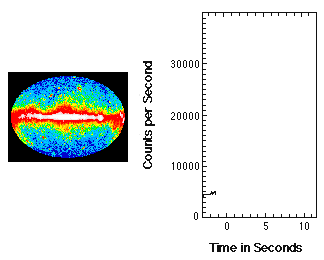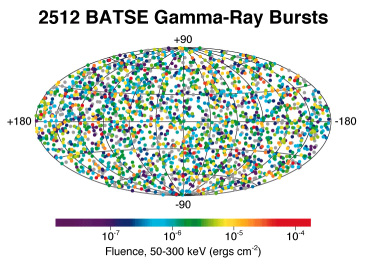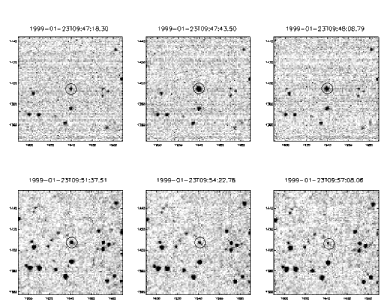Gamma-Ray Bursts
The Biggest Explosions in the Universe
In Compton's album of greatest hits, gamma-ray bursts (GRBs) would be the
torch song -- the tune that gets everyone off their seat with lighters
flashing high in the air screaming for more. Although these bursts
were known about since 1967, Compton was the first satellite that
truly enabled an in-depth study of the phenomenon.
GRBs are the most energetic events known in the Universe, second only
to the Big Bang in
power. During this fantastic flash -- ranging
from as short as a few milliseconds to as long as a minute or more --
the burst can outshine the rest of the Universe. Then it disappears
forever. The nature and origin of the bursters remains unknown.

|
|
The time history of a gamma ray burst. Left hand side shows the gamma
ray sky as the burst brightens and fades. Right hand side shows how
the gamma ray intensity rises and falls through the course of the burst.
|
Prior to Compton, the 300-some known GRBs were thought to be
associated with Galactic
neutron stars, with
a distribution that would trace the Galactic plane. BATSE, many assumed, would simply
confirm this scenario, after which GRBs would be relegated to an
insignificant place in high-energy astrophysics research.
Instead, BATSE showed the GRB distribution to be isotropic, or spread
out uniformly across the sky, and to be spatially limited (i.e. the
distribution has an edge). This rules out the hypothesis that GRBs
are objects in our own Galaxy, and favors the notion that the 2,500
GRBs from BATSE originated at cosmological
distances, well beyond our Galaxy.

|
BATSE Distribution of GRBs. Fluence is a
measure of the total energy emitted in the burst.
(CREDIT: CGRO BATSE Team)
|
BATSE provided gross localizations of bursts, relayed to the
astronomical community in near real-time. The idea is that someone
somewhere with something will record the burst before it fades from
view. On January 23, 1999, BATSE aided ROTSE-I in catching the first
optical counterpart of a GRB while it was bursting. The burst had
reached ninth magnitude and would have been visible with a good pair
of binoculars. The Beppo-SAX satellite detected an afterglow that
allowed measurements proving that the gamma ray bursts are at
cosmological distances.

|
|
Sequence of 6 ROTSE-I images of the fading optical counterpart
to GRB 990123 |
BATSE may be in retirement, but there may be gold in its treasure
chest of data. Characteristics in the bursts' light curves appear to
be a promising way to determine distance, allowing them to be used as
cosmological probes.
Additional Links
 CGRO Web Site (http://cossc.gsfc.nasa.gov/) CGRO Web Site (http://cossc.gsfc.nasa.gov/)
| 